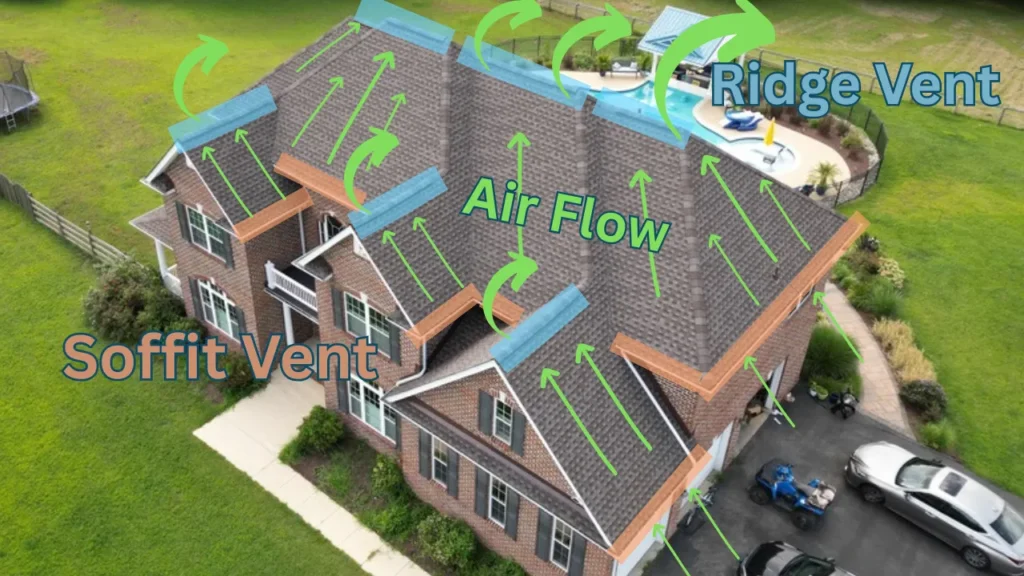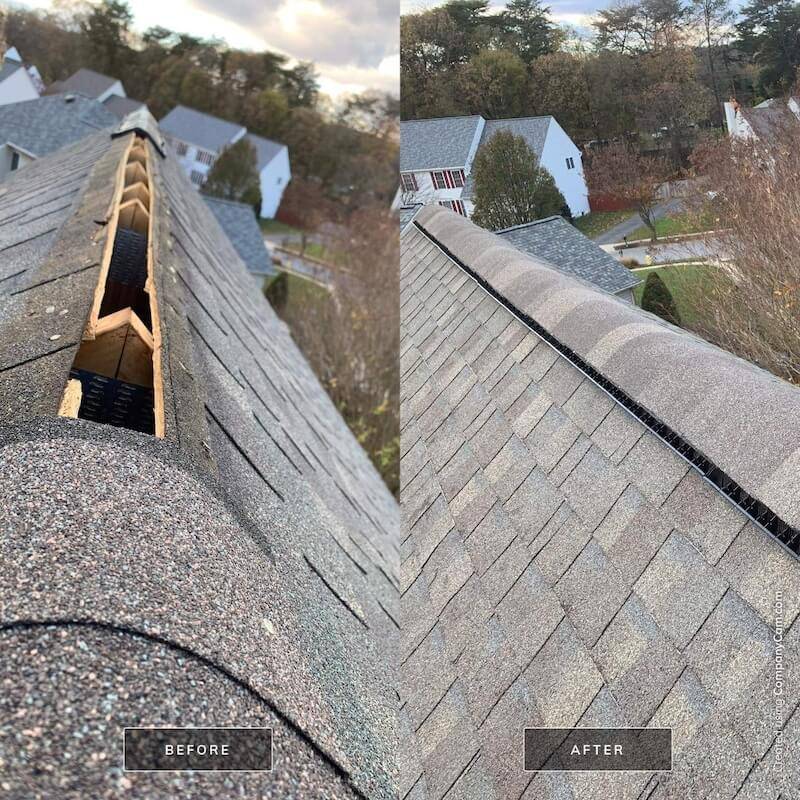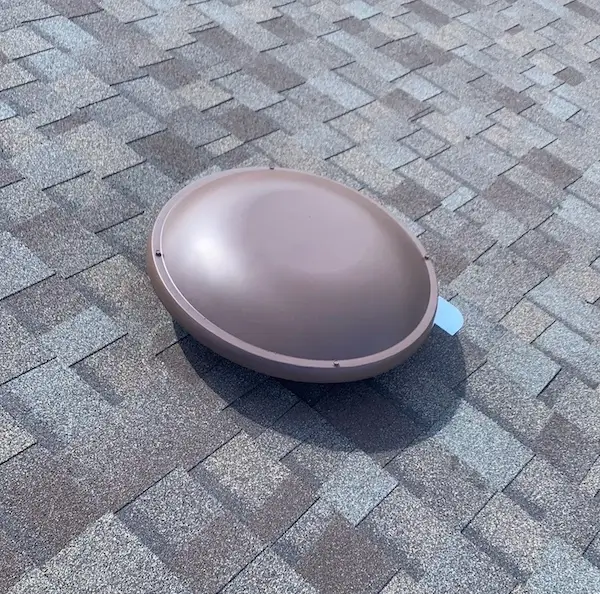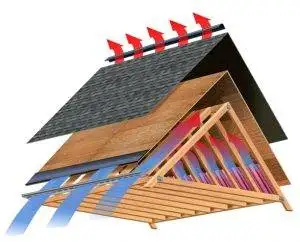When it comes to ridge vent vs attic fan, both options help your attic breathe, but they work in different ways. Ridge vents are passive, so they need no power, and they rely on natural airflow with good soffit intake. Attic fans are active, using a motor or solar power to pull hot air out faster, which can help when your home has a complex roofline or extreme heat buildup. For most homes, ridge vents are the best fit when the peak is long enough and the soffits are open. You can combine both, but only with careful placement, because the wrong setup can disrupt airflow and make the whole system less effective.

How Ridge Vents Work
Ridge vents are a passive exhaust vent system that runs along the peak of your roof. It works because hot air rises. As warm, moist air collects near the top of the attic, it naturally escapes through the ridge vent. That outgoing air pulls in fresh, cooler air through the soffit vents at the eaves of your home. That soffit-to-peak airflow is the goal with soffit and ridge vents.
When intake and exhaust are balanced, air moves in a steady path from the soffits up to the ridge, helping your home stay cooler and your attic stay drier, especially in a hot or humid climate, without using electricity.

How an Attic Fan Works
Attic fans are active exhaust systems that use a motor or solar power to pull hot air out of the attic. When the fan turns on, it creates suction that draws fresh air in through intake vents, usually at the soffits. Many models use a thermostat to switch on when attic temperatures rise. As air enters low and exits through the fan, heat and moisture are pushed out faster than a passive system can manage on its own.
The key is balance. If the attic does not have enough intake, the fan can struggle to move air evenly and may start pulling air from the wrong places in your home instead of ventilating the whole attic.

You Need a Balanced System
This is where most attic ventilation problems start. No matter which system you choose, your home needs a balanced mix of intake and exhaust. Ventilation is just one of the parts of a roof system, so it needs to match your roof design and attic layout.
Intake vs Exhaust: Why Balance Matters
Attic ventilation only works when air has a clear path in and a clear path out. Intake vents, usually at the soffits, bring in cooler outdoor air. Exhaust vents, like ridge vents or attic fans, let hot, moist attic air escape.
If you add a lot of exhaust without enough intake, the system can pull from the wrong places and leave parts of the attic with weak airflow. If you have plenty of intake but not enough attic exhaust, heat and moisture still get trapped near the roof deck. The goal is steady, even movement from low intake to high exhaust.
How Much Ventilation You Need in Simple Terms
Start with your attic floor area. Most manufacturer guides use net free vent area, called NFVA, to size ventilation. NFVA is the clear opening after screens and louvers reduce airflow. Each vent type has a different NFVA rating, so sizing depends on the product. Many standards use a 1:150 ratio, meaning one square foot of NFVA per 150 attic square feet. Some allow 1:300 when conditions are met. Split the total NFVA between intake at the soffits and exhaust near the ridge. Aim for a balanced split, with intake equal to or slightly greater than exhaust.
Ridge Vent Pros and Cons
Ridge vents are one of the simplest ways to vent an attic. They sit along the roof peak and let warm, moist air escape along the full length of the ridge. When they are paired with clear soffit intake, it can keep airflow steady without adding anything powered.

Pros:
- No electricity or moving parts: Ridge vents are passive. There is no motor to fail and no wiring to maintain.
- Low maintenance and long lifespan: Once it is installed correctly, there is very little to service over the life of the roof.
- Even roof ventilation across the entire roofline: Because it runs along the ridge, it can exhaust air more evenly than a single fan or box vent.
- Clean look under shingles: Shingle-over systems sit low and blend into the roofline, so they do their job without standing out.
- Often preferred for warranty-friendly ventilation setups: Many shingle manufacturers want balanced attic ventilation. Ridge and soffit ventilation is a common way to meet those guidelines.
Cons:
- Not ideal when the ridge line is very short: If there is not enough ridge length, the vent may not provide enough exhaust for the attic.
- Lower-quality ridge vents or poor installs can allow wind-driven rain: Product design and installation details matter. A low-quality vent or sloppy installation can lead to water intrusion during heavy wind and rain.
- Needs clear soffit intake to work well: Ridge vents cannot pull air that is not there. Blocked soffits, clogged screens, or insulation covering intake vents can make the system underperform.
- Can underperform on complex rooflines with multiple ridges and valleys: If the roof is broken into sections, airflow can get uneven. Some attic areas may ventilate well while others stay hot.
Ridge Vent Types Aluminum vs Shingle Over

Field Note: What We See on Real Attic Inspections
Most ventilation problems are not caused by the ridge vent itself. The issue is usually intake. We often find soffit vents painted shut, blocked by debris, or covered by insulation inside the attic. Once intake is opened and the airflow path is restored, ridge vents usually perform the way they were intended.
A common example is after new insulation is added. Without proper baffles, insulation can slide into the eaves and block the intake path. We’ve corrected this on many homes by installing baffles and clearing the soffit channels so air can move again. We also see intake vents blocked during exterior painting when paint seals the vent openings, or after siding work when vents are covered instead of replaced. Most of the time, it comes down to workmanship, not the ventilation design.
Attic Fan Pros and Cons
An attic fan is an active exhaust system. It uses a motor, or solar power, to pull air out of the attic. When it is paired with enough intake, it can move air faster than a passive system and help in situations where ventilation along the peak is limited.

Pros:
- Moves heat out fast in an extreme climate: Attic fans can quickly lower the attic air temperature during intense heat, especially in attics that trap hot air.
- Works on homes with limited ridge length: If your roof does not have a long, continuous peak, a fan can provide exhaust where ridge vents cannot.
- Helps hard-to-vent areas and complex rooflines: On roofs with multiple sections, hips, valleys, or tight attic spaces, a fan can help pull air from areas that struggle to ventilate naturally.
- Solar models can reduce operating costs: Solar fans still provide active exhaust without adding to your electric bill in the same way a wired fan can.
Cons:
- Motor can fail and may need replacement: Fans rely on moving parts. Motors wear out, and a failed fan can leave the attic with little to no exhaust.
- Uses electricity unless solar powered: Electric models add operating costs, and some homeowners prefer a passive setup for that reason.
- Can pull conditioned air from the house if the attic is not air-sealed: If there are gaps around attic hatches, recessed lights, or duct leaks, a fan can pull cooled or heated indoor air into the attic instead of pulling fresh outside air.
- Can short cycle and leave dead zones if intake is weak or placement is wrong: Without enough soffit intake, or if the fan is placed poorly, the fan may pull air from the nearest opening instead of moving air across the whole attic.
- Has moving parts that wear out over time: Even when they work well, fans usually require more attention over the life of the roof than passive vents.
Field Note: When a Fan Is the Only Option
We’ve been called out to plenty of homes where an attic fan was added to a mixed system and ended up doing more harm than good. In those setups, the fan often pulls from the nearest opening instead of the whole attic, which creates dead zones and uneven airflow. We’ve had to remove fans, relocate them, or rework intake so the air moves the way it should.
We’re also often called in after a fan stops working without anyone noticing. The motor can fail and sit dead for months, and homeowners do not realize it until heat and moisture start building up in the attic. That is why, when a fan is the right choice, we focus just as much on intake and attic air sealing as the fan itself.
Why Attic Fans and Ridge Vents Usually Do Not Work Together
At first, it sounds like a great idea to combine a ridge vent and an attic fan. More exhaust should mean a cooler attic. The problem is that ventilation only works when air follows the right path. When you mix systems without a plan, the fan can end up stealing air from the peak instead of pulling fresh air through the soffits.
Short Cycling: Why the Fan Pulls From the Ridge Vent
An attic fan creates strong suction. If ridge vents are nearby, that vent can become the fan’s easiest air source. Instead of pulling cooler air in through the soffits and flushing the entire attic, the fan may pull air from the ridge vents and exhaust it right back out. That is short cycling. The fan is moving air, but it is not moving the right air, and the attic does not ventilate evenly.

Dead Zones and Uneven Roof Ventilation
Short cycling also creates dead zones. The areas closest to the fan may get airflow, while other sections of the attic stay hot and humid because fresh air never reaches them. This is common on long attics, multi-level rooflines, and homes with multiple attic sections. The result is uneven temperatures, moisture pockets, and ventilation that looks good on paper but does not work in real life.
When a Fan Can Pull Air From the Living Space
If soffit intake is limited or blocked, a fan will still try to get air from somewhere. That “somewhere” can be your home. Air leaks around attic hatches, recessed lights, duct chases, and bath fan penetrations can feed the fan. When that happens, the fan can pull conditioned air into the attic, which wastes energy and can increase moisture issues instead of fixing them. That is why intake and attic air sealing matter as much as the fan itself.
Can You Use Ridge Vents and an Attic Fan Together?
Yes, a hybrid setup can work, but it is not the default choice. It only works when the airflow path is planned so the fan pulls fresh air in from the soffits and moves it through the attic, instead of pulling from the other vents along the peak.
When a Hybrid Setup Can Work
A hybrid setup can make sense when part of the roof ventilates well with ridge and soffit vents, but another section still traps heat because the roofline is broken up. It can also help in extreme heat conditions when passive ventilation is sized correctly but you still need an extra push during the hottest stretches. The key is that the ridge vent remains the main exhaust path, and the fan is used as a targeted solution, not a “more is better” add-on.
Rules for Doing It Safely
Place the fan away from the ridge vent.
If the fan is too close to the peak, it will often pull from the ridge vent and short cycle. Placement should encourage the fan to pull air across the attic, not from the nearest opening.
Prevent short cycling if needed.
In some layouts, it may make sense to close off a section of ridge vent near the fan so the fan cannot steal air from it. This is not always required, but it can be the difference between moving air properly and just spinning air in circles.
Confirm intake is strong first.
A fan can only work as well as the intake allows. Before adding a fan, make sure soffit vents are open, unobstructed, and not covered by insulation.
When You Should Choose One System Over the Other
If your roof has a good ridge line and the soffits are open, a properly sized ridge vent system is usually the cleanest long-term solution. If the roofline is too short, too complex, or has isolated heat pockets that passive ventilation cannot reach, exhaust fans can be the better tool. In most homes, a single well-designed system performs better than mixing systems that end up competing with each other.
Which Option Should You Choose?
Choose a Ridge Vent If
- Your roof has a continuous ridge line with enough length to vent properly.
- Your soffit vents are open and can bring in steady intake air.
- You want a low-maintenance system with no power or moving parts.
- You prefer even ventilation across the whole attic instead of a single strong exhaust point.
Choose an Attic Fan If
- Your ridge line is short, broken up, or does not allow a continuous vent along the peak.
- Your roof design creates heat pockets that passive ventilation cannot clear well.
- You need more aggressive exhaust during extreme heat periods.
- You can confirm you have enough intake to support a powered exhaust system.
Before You Install Anything, Check These Items First
- Soffit intake is open. Make sure vents are not painted shut, clogged, or blocked by insulation.
- Bath fans vent outside. Fans should exhaust outdoors, not into the attic.
- The attic is air-sealed. Seal leaks around attic hatches, penetrations, and duct chases so airflow comes from outside intake vents.
- Insulation is not blocking intake. Use baffles at the eaves so insulation stays back and air can move from soffits into the attic.
Ridge Vent vs Attic Fan FAQs
Yes, but only in specific layouts and with careful planning. The fan has to be placed so it pulls fresh air from the eaves, not from the ridge vent. If the setup short cycles, the fan will move air without ventilating the whole attic.
The attic will struggle to get fresh air, so airflow becomes weak and uneven. A powered fan may start pulling air from the easiest openings, which can include other vents at the peak, gable vents, or even leaks from the living space. The result can be hot spots, moisture pockets, and wasted energy.
Common signs include a hot upstairs, musty attic smells, or moisture and staining near the roof deck. In the attic, look at the eaves. If insulation is packed tight to the roofline or you cannot see daylight at the soffit area, intake may be blocked. Outside, check for paint, debris, or new siding that may have covered vent openings.
Start with your attic floor square footage and use NFVA guidelines to estimate total vent area. Many standards use a 1:150 total vent area ratio, with some roofs qualifying for 1:300 when conditions are met. Then split the total between intake at the soffits and exhaust near the peak. Aim for intake equal to or slightly greater than exhaust.
NFVA stands for net free vent area. It is the amount of open area a vent actually provides after screens and louvers reduce airflow. It matters because vents with the same outside size can have very different real airflow. Using NFVA keeps your intake and exhaust sizing accurate.
It can help move hot air, but it can also create new problems. If the attic is not air sealed, the fan may pull conditioned air from the living space through gaps, recessed lights, duct leaks, or attic hatches. That wastes energy and can increase moisture movement into the attic. Air sealing first usually makes any ventilation system work better.
Need Help Choosing the Right Attic Ventilation for Your Home?
Attic Ventilation Inspection and Recommendations
If you are not sure which option fits your home, a quick attic inspection is the best place to start. Our team checks your intake and exhaust, looks for blocked soffits, insulation issues, and moisture signs, and then recommends a setup that matches your home’s design. RoofPRO is a manufacturer-certified contractor with a strong track record and an A+ BBB rating, so you can feel confident you are getting advice based on real installs, not guesswork.
Get a Quote for Ridge Vent or Attic Fan Installation
Ready to fix a hot attic or moisture problem for good? Contact us and we’ll provide a clear quote for vent installation, attic fan installation, or repairs to existing ventilation. You will get straightforward options for your home, honest recommendations, and workmanship you can rely on from a local team that stands behind its work.

Author Bio
Tim Taylor – Owner & Founder of RoofPRO
Tim Taylor began roofing in 2003 and founded RoofPRO in 2004 to fight poor workmanship. With over 20 years of hands-on experience, he focuses on leak repair, flashing, and post-storm restoration. He holds CertainTeed ShingleMaster Wizard credentials, HAAG inspection certifications, and OSHA safety training. In 2025, he was named a finalist for the BBB Torch Awards for Ethics in Greater Maryland. He also leads RoofPRO to serve the community through veteran roof relief projects with Habitat for Humanity and Owens Corning. Tim still runs the team on one rule: roof it right the first time.


